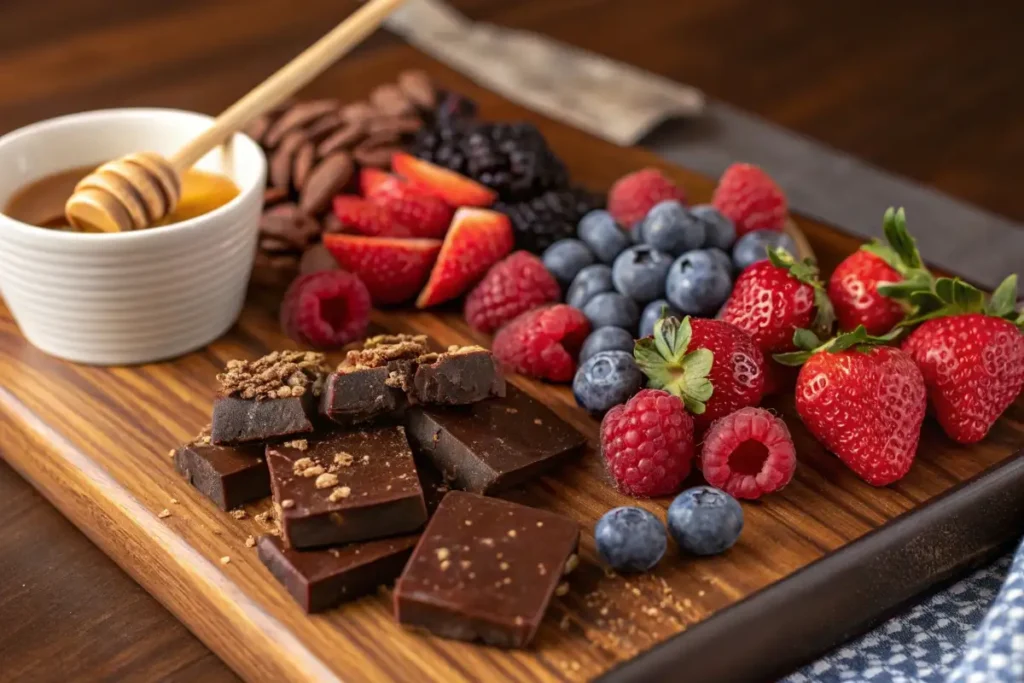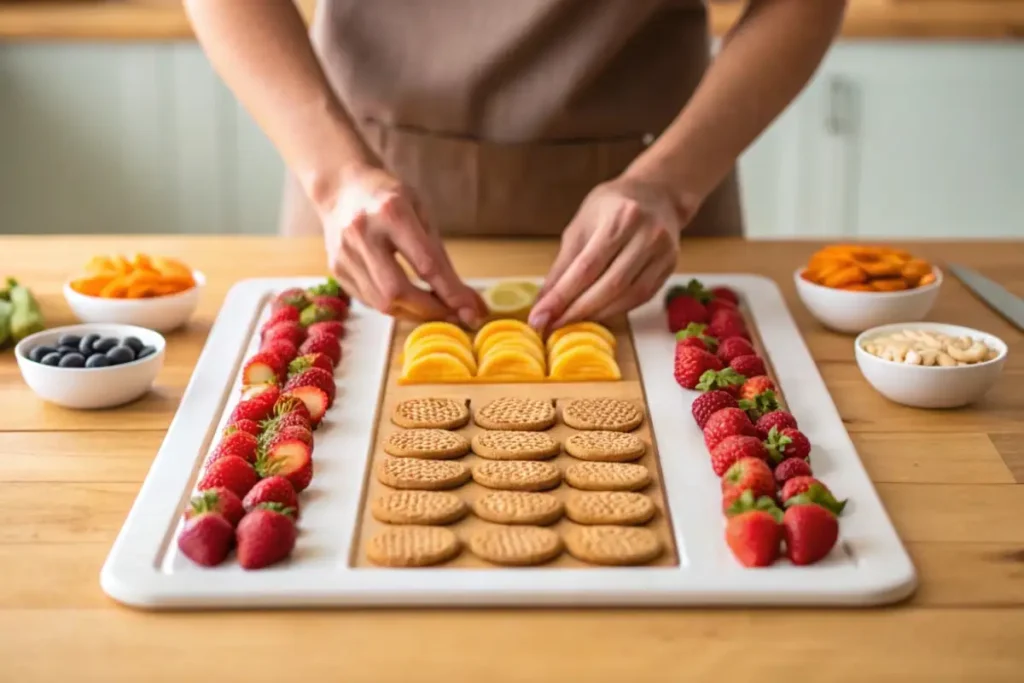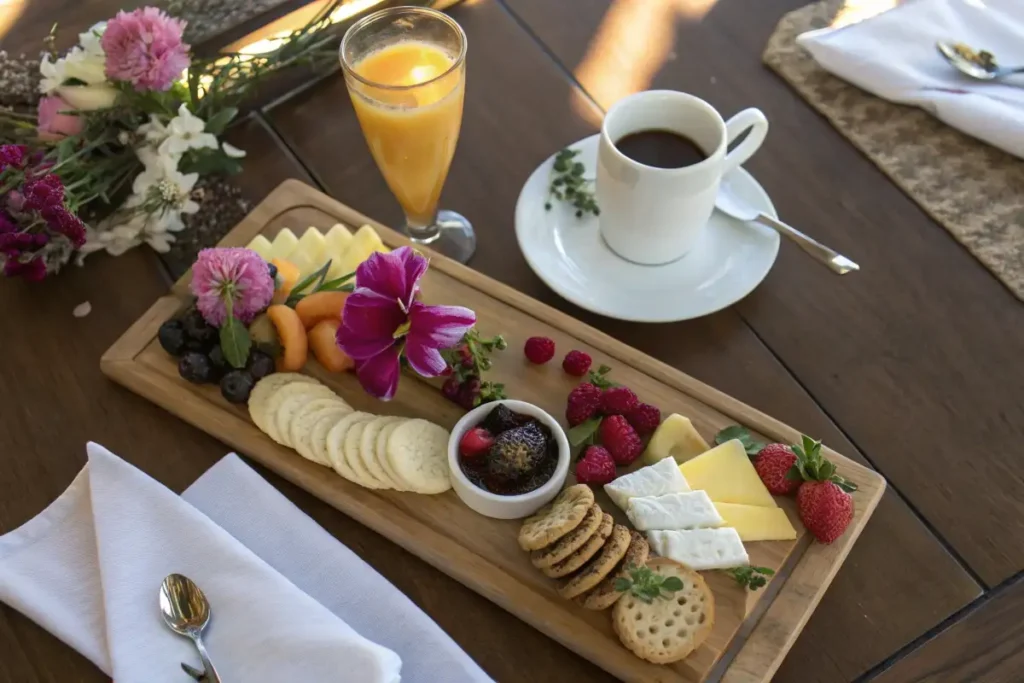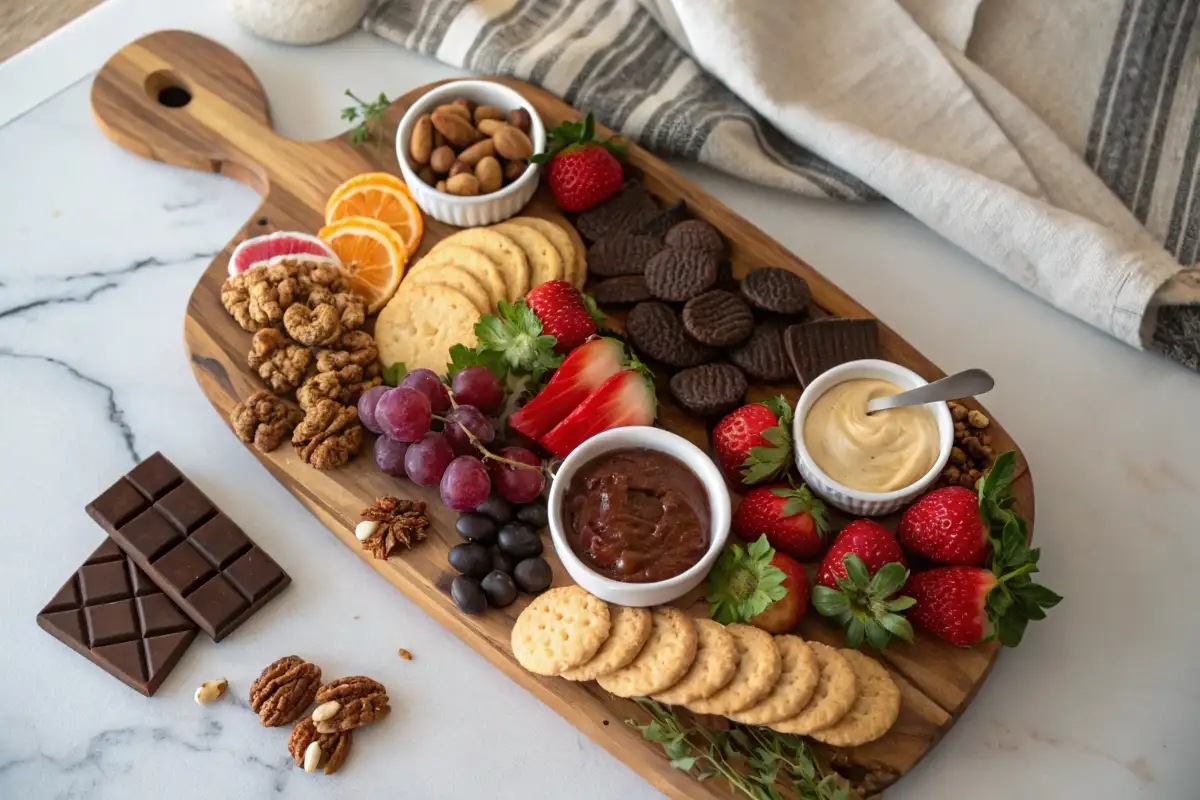Who said charcuterie boards were just for meats and cheeses? The dessert “charcuterie” board is the ultimate way to serve an assortment of sweet treats in a visually stunning, shareable spread. Whether you’re hosting a party, celebrating a special occasion, or just looking for a fun way to enjoy desserts, a well-designed sweet board can be the star of the table.
In this guide, we’ll walk you through everything you need to know about creating a show-stopping dessert platter. From selecting the best treats to arranging them in an eye-catching way, you’ll learn how to make a board that impresses both the eyes and the taste buds. Plus, we’ll share pairing tips, serving advice, and creative themes to elevate your presentation.
Introduction to Dessert “Charcuterie” Boards
What is a Dessert “Charcuterie” Board?
A dessert “charcuterie” board is a beautifully arranged platter of assorted sweets, designed for easy sharing. Inspired by the classic savory charcuterie board, this version swaps meats and cheeses for chocolates, cookies, fruits, nuts, and sweet spreads. The goal? To create a balance of flavors, textures, and colors that delights every guest.
Unlike a traditional dessert tray, this board is interactive, allowing people to mix and match flavors while enjoying a visually appealing spread. It’s an Instagram-worthy addition to any gathering, from holiday celebrations to casual get-togethers. Plus, it’s completely customizable, so you can tailor it to match your preferences, dietary needs, or seasonal themes.
The Rising Popularity of Dessert Boards
Lately, dessert charcuterie boards have taken over social media and event trends. Why? Because they’re fun, easy to assemble, and make a statement at any occasion. Unlike a traditional plated dessert, these boards encourage guests to sample different treats and create their own sweet pairings.
From birthday parties to baby showers, these boards fit any celebration. Plus, they cater to a wide range of tastes—whether someone loves rich chocolates, fruity bites, or crunchy cookies, there’s something for everyone. With endless possibilities, it’s no surprise that dessert boards have become a go-to choice for hosts looking to impress.
Essential Components of a Dessert “Charcuterie” Board
Building the perfect dessert “charcuterie” board starts with selecting the right mix of flavors, textures, and colors. A well-balanced board should have sweet, crunchy, creamy, and fresh elements to create an exciting eating experience. Whether you’re aiming for a classic, elegant, or themed board, here are the must-have components.
Base Elements
The foundation of your board should include a variety of bite-sized, easy-to-eat sweets. These should be sturdy enough to handle dipping and pairing with other treats.
- Cookies and Biscuits – A mix of soft and crunchy cookies, such as chocolate chip, shortbread, macarons, or ginger snaps, adds depth to the board.
- Assorted Chocolates – Including dark, milk, and white chocolates ensures there’s something for everyone. Chocolate truffles, bark, and chocolate-covered nuts also work well.
- Brownies and Mini Cakes – Fudgy brownies, blondies, and mini cupcakes add a rich, decadent touch. Cut them into small portions for easy snacking.
Fresh and Dried Fruits
Adding fruit to your dessert “charcuterie” board provides natural sweetness and a refreshing contrast to heavier desserts.
- Fresh Fruits – Use strawberries, raspberries, grapes, sliced apples, and oranges for bursts of color and freshness.
- Dried Fruits – Options like apricots, figs, cranberries, and banana chips add chewiness and complement chocolate and cheese pairings.

Cheese Selections
Surprisingly, cheese pairs beautifully with sweets! A few mild and creamy cheese options can elevate the board.
- Brie and Camembert – Their mild, buttery flavor complements honey, nuts, and fruits.
- Mascarpone and Cream Cheese – Perfect for spreading on cookies or dipping fruit.
- Ricotta or Goat Cheese – Lightly sweetened versions balance out richer chocolates and nuts.
Nuts and Sweet Spreads
To add crunch and depth to your board, sprinkle in roasted or candied nuts and creamy spreads.
- Almonds, Pecans, and Walnuts – A mix of raw and candied nuts enhances texture.
- Sweet Spreads – Honey, caramel, chocolate ganache, or Nutella are perfect for drizzling or dipping.
With these elements, your board will be packed with variety and flavor, making it a crowd-pleaser at any gathering.
Designing and Assembling Your Dessert Board
Now that you’ve chosen the perfect selection of sweets, it’s time to arrange them in a way that’s both aesthetic and functional. A well-assembled dessert “charcuterie” board is all about balance, color, and accessibility. Here’s how to bring it all together.
Choosing the Right Board
Before arranging your treats, you need a suitable base. The size and material of your board can affect the overall presentation.
- Wooden Boards – A classic choice that adds a rustic and cozy feel.
- Marble or Slate – Ideal for elegant gatherings, these surfaces keep chocolates cool.
- Serving Trays or Large Platters – Great for larger groups and easy mobility.
Arrangement Techniques
The secret to a visually stunning dessert “charcuterie” board is how you place the ingredients. Follow these steps for a beautiful and practical design:
- Start with Large Items – Place cheeses, small bowls of spreads, and larger cookies or brownies first.
- Layer in Medium-Sized Treats – Arrange fruit, chocolates, and smaller pastries around the larger elements.
- Fill the Gaps – Use dried fruit, nuts, or candies to fill any empty spaces. This makes the board look full and inviting.
- Balance Colors and Textures – Contrast dark and light elements to make each component stand out.

Incorporating Themes and Seasonal Elements
To make your dessert “charcuterie” board even more special, consider a theme or a seasonal twist.
- Holiday-Themed Boards – For Christmas, use peppermint bark, gingerbread cookies, and red-and-green accents. For Halloween, add candy corn, pumpkin-shaped chocolates, and orange-tinted treats.
- Romantic Themes – Valentine’s Day boards look great with heart-shaped chocolates, strawberries, and pink macarons.
- Summer and Tropical Styles – Use pineapple, mango, coconut-covered truffles, and colorful gummy candies.
With these styling tips, your board will be both beautiful and delicious, making it the highlight of any event. Up next, we’ll talk about pairing drinks to complement your sweet spread!
Pairing Beverages with Your Dessert “Charcuterie” Board
Choosing the right drinks to accompany your dessert “charcuterie” board can elevate the tasting experience. The goal is to complement the sweet flavors without overwhelming the palate. Here are some delightful options:
Wine Pairings
For those who enjoy wine, certain varieties pair wonderfully with desserts:
- Sweet Wines: Moscato, Riesling, or Sauternes offer a light sweetness that harmonizes with many treats on your board.
- Sparkling Wines: A chilled Prosecco or Champagne adds a refreshing contrast to rich chocolates and creamy cheeses.
Non-Alcoholic Options
If you prefer non-alcoholic beverages, consider these choices:
- Teas: Herbal teas like chamomile or mint provide a soothing balance to sugary items. Chai tea offers warm spices that pair well with cookies and cakes.
- Coffees: A mild latte or cappuccino complements sweet flavors without adding too much bitterness.
- Mocktails: Create a sparkling berry lemonade or a virgin mojito for a fruity and refreshing pairing.

By thoughtfully selecting beverages, you enhance the overall enjoyment of your dessert “charcuterie” board, ensuring each bite and sip work in harmony.
Tips for Serving and Enjoying Your Dessert “Charcuterie” Board
To make the most of your dessert “charcuterie” board, consider these serving suggestions:
Serving Utensils and Accessories
Providing the right tools ensures guests can easily enjoy the spread:
- Tongs and Spoons: Small utensils help in picking up items without mess.
- Spreaders and Knives: Useful for cheeses and spreads.
- Plates and Napkins: Ensure ample supply for guests’ convenience.
Storage and Preservation
Maintaining the freshness of your board is key:
- During the Event: Keep perishable items like cheeses and fresh fruits cool, especially if outdoors. Consider placing the board in a shaded area or using chilled trays.
- Handling Leftovers: Store remaining items in airtight containers. Cookies and chocolates can be kept at room temperature, while fruits and cheeses should be refrigerated promptly.
By following these tips, your dessert “charcuterie” board will not only look appealing but also provide a delightful and hassle-free experience for your guests.
For more delicious recipes, check out our recipe article.
FAQs
Creating a dessert “charcuterie” board is simple, but you might have a few questions about getting it just right. Here are answers to some common concerns:
A well-balanced dessert grazing board should have a variety of textures, flavors, and colors. Here’s what to include:
Base Sweets: Cookies, brownies, macarons, mini cupcakes
Chocolates: Dark, milk, white chocolate, chocolate-covered nuts
Fruits: Fresh berries, grapes, apple slices, dried fruits
Cheeses: Brie, mascarpone, cream cheese for balance
Nuts & Crunchy Items: Candied pecans, almonds, wafer cookies
Dips & Spreads: Caramel, Nutella, honey, marshmallow fluff
Mix and match these elements to create an aesthetic and flavorful dessert board.
Avoid these 5 common mistakes to keep your charcuterie board fresh and enjoyable:
Messy or Melting Foods – Avoid ice cream, whipped cream, or anything that melts quickly
Overpowering Flavors – Skip extra-strong cheeses or spices that clash with sweet flavors
Too Many Dry Items – Balance dry cookies and nuts with fresh elements
Limited Variety – A board should have different textures and flavors to be exciting
Not Enough Serving Tools – Provide tongs, spoons, and spreaders so guests can easily serve themselves
By avoiding these, your dessert charcuterie board will be beautiful, well-balanced, and easy to enjoy!
Conclusion
A well-designed dessert “charcuterie” board is more than just a collection of sweets—it’s an experience. By combining different textures, flavors, and colors, you create a spread that excites both the eyes and the taste buds.
Remember to focus on balance—too many heavy desserts can be overwhelming, while a mix of light, crispy, creamy, and fruity elements keeps things interesting. Don’t be afraid to get creative! Seasonal themes, decorative elements, and personalized touches make your board even more special.
Whether you’re hosting a holiday gathering, birthday party, or casual get-together, a thoughtfully arranged dessert board is sure to impress. Plus, it’s an easy way to let guests mix and match their favorite flavors.
Now that you know how to build the perfect board, it’s time to start gathering your favorite treats. Have fun with it, and enjoy sharing your sweet masterpiece with family and friends!


2 thoughts on “How to Make a Perfect Dessert “Charcuterie” Board for Any Occasion”